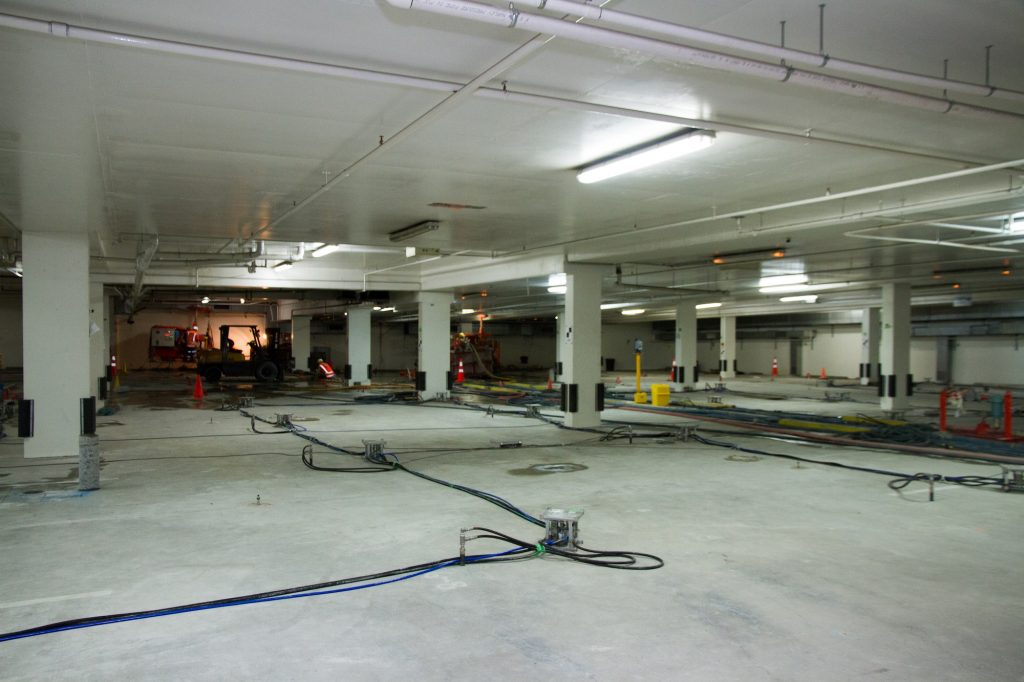
A Sign Of Subsidence
How to Fix Uneven Concrete Slabs
Sinking concrete floors or slabs are an indication of building subsidence
Uneven concrete slabs can occur due to settling, poor installation, or natural wear and tear. Fixing them depends on the extent of the unevenness and the underlying cause. Below are the best methods to correct uneven concrete surfaces, from minor imperfections to major issues.
Video
Residential Sinking Floor & Slab
Our Teretek® Resin Injection technology can raise, re-level and re-support sinking floors and slabs.
Watch how our non-invasive, cost-effective technology raises and re-levels a sinking residential internal floor and external concrete slab.


Sinking Floor & Slab Repairs
Before & After Treatment
Houses that need to be re-levelled often experience internal and external sinking floors and slabs.
These houses require their foundations to be re-levelled.
Mainmark’s non-invasive and cost-effective solutions can raise, re-level and re-support your home. Our innovative methods minimise site disruption and are completed within one day.
Features & Benefits
Mainmark’s Solutions & Technologies

Fast
Our technologies have fast curing times and treated areas can be used immediately or without the delays compared to traditional repair methods.

Environmentally Inert
Our technologies use an inert material that is non-toxic and does not leach into the environment or affect the treated area.

Non-Invasive
Our solutions are of surgical nature compared to traditional methods.

Cost-Effective
Compared to traditional methods, our solutions are more cost-effective, with minimal disruption to the area.

External Sinking Floors or Slabs
Outside Your Home
You may also notice sinking or gaps in concrete slabs outside your home, such as in your driveways, paths and patios.
If these outdoor areas are experiencing sinking, it could also indicate deeper issues underground.
The risks outside can vary, but include damage to underground wiring or services, drainage breaks or leaks, and other safety hazards.
Re-levelling your concrete here is key to ensuring a safe, functioning, and aesthetic outdoor space.
What causes sinking floors and slabs?
There are many different causes of subsidence and various contributing factors.
All involve some change in the ground, which, in turn, generates movement of the soil.
As well, different types of ground are more affected by different conditions.
When ground has been affected, building subsidence is common. Foundations or footings are no longer fully supported, sinking due to weak ground.
Soil Types
Moisture levels in the soil affect reactive clays as they expand and contract.
Oversaturated clays lose their strength resulting in footing subsidence. In loosely packed soils, such as sand and silt, the fine particales in the soil can wash away causing the footing to settle.
Tree Roots
Neighbouring trees and shrubs absorb water using their roots causing movement in the soil as it soaks up moisture in the ground.
Footing Systems
Poor foundation design or inadequate compaction of soil during construction results in movement of the structure as it settles.
Excess Water
Burst or cracked water pipes including blocked sewage and rain gutters can oversaturate clay soils or wash fine particles from sand and silt soils and cause footings to subside.
Extreme or Seasonal Weather
Natural disasters such as flooding, drought and earthquakes affect soil moisture levels in particular clay resulting in excessive foundation movement.
Renovation or Construction
Vibration caused by nearby construction activity such as drilling or piling, or heavy road traffic causes soil particles to shift and settle, resulting in ground subsidence.
Sinking Floor FAQs
How to fix uneven Concrete Slabs
Understanding Concrete Slab Damage
Concrete slabs endure wear and tear over time. Understanding the damage is key to effective repair and prevention.
What are the signs of damage? Look for cracks, uneven surfaces, or discoloration. These can all indicate deeper problems.
Why does damage occur? Several factors can affect the integrity of a concrete slab.
Here’s how to tell if your concrete needs attention:
- Cracks in the slab surface
- Visible fractures or splits
- Uneven or sinking areas
- Water pooling on the surface
Addressing the issues promptly is crucial. Ignoring them can lead to bigger problems down the road.
Every type of crack tells a different story. Understanding these can help in determining the right repair approach.
Proper identification helps in choosing the most effective repair strategy. It also ensures the slab’s longevity and stability.
Common Causes of Concrete Slab Damage
Concrete slabs can suffer from various types of damage. Soil settlement is a common cause. When soil shifts, slabs lose support and crack.
Excessive loads can also harm slabs. Heavy vehicles or equipment stress the concrete beyond its limits.
Another factor is environmental conditions. Freezing and thawing cycles can expand and contract the concrete, leading to cracks.
Avoidable damage comes from inadequate drainage. Water buildup erodes the soil beneath the slab, causing instability.
Each cause requires a different preventive measure. Identifying the root cause is the first step in preventing future damage.
Types of Concrete Cracks and Their Implications
Concrete cracks vary in severity. Hairline cracks are shallow and often appear without compromising structure.
Structural cracks, however, are more serious. They could indicate foundational issues and require immediate attention.
Shrinkage cracks occur as concrete cures and loses moisture. These are mostly cosmetic and rarely threaten the integrity.
Properly understanding these cracks is crucial. It helps in applying the right concrete crack repair methods.
Ignoring crack types can lead to costly repairs later. Careful assessment can save time and resources.
Knowing the implications of each crack guides effective concrete slab crack repair decisions.
Assessing the Extent of Damage
Assessing concrete damage requires a keen eye. Begin by visually inspecting the entire surface. Look for visible cracks or unevenness.
Next, use a level or straightedge to check for deviations. This helps identify any sinking or uneven spots.
Lastly, tap the surface gently with a hammer. A hollow sound can indicate voids or delaminated areas beneath the slab. Evaluating the depth and size of cracks is crucial.
Not all cracks are created equal. Measuring them helps determine severity. Recording findings ensures nothing gets overlooked.
Documenting these observations assists in planning effective repairs. It also helps in deciding whether professional intervention is necessary.
Step-by-Step Guide for Damage Assessment
Start by cleaning the area. Remove debris and dirt to expose all existing damage.
Next, use a flashlight to inspect hard-to-see areas. Some cracks may not be visible under natural lighting.
Measure the width of each crack with a tape measure. This determines the repair method needed.
Use a moisture meter to check for water intrusion. Excess moisture can exacerbate existing issues.
Finally, mark all findings with chalk or tape. This provides a clear visual map for your concrete slab repair plans.
By following these steps, you can gauge the necessary efforts for restoration. This methodical approach saves time and prevents oversight.
Preparing for Concrete Slab Repair
Proper preparation sets the stage for successful concrete slab repair. Start by gathering necessary tools and materials. Having everything at hand streamlines the process.
Assess the weather conditions. Weather can impact repair work, especially the curing process. Choose a day with moderate temperatures and no rain.
Ensure safety by wearing appropriate protective gear. Gloves, goggles, and masks keep you safe from dust and chemicals. Safety should never be compromised during repair work.
Cleaning and Preparing the Damaged Area
Begin by thoroughly cleaning the damaged area. Sweep away loose debris and dust. A clean surface ensures better adhesion for repair compounds.
Next, use a pressure washer to remove ingrained dirt. This helps in exposing fine cracks that might be hidden. Dry the area completely to avoid moisture issues.
Lastly, use a concrete cleaner or mild detergent to treat the surface. This step eliminates any oil or grease. Ensuring a pristine surface before repair enhances the longevity of the fix.
Selecting the Right Repair Materials
Choosing the correct materials is crucial in concrete slab repair. The material must match the type and extent of damage. It ensures durability and effectiveness.
Research different products available for concrete repair. Some are specifically designed for small cracks, while others cater to significant structural issues. Make an informed decision based on the repair needs.
Consult with professionals if unsure about material suitability. They can guide you to the best options for your project. This helps prevent costly mistakes and rework.
Epoxy vs. Polyurethane: Which to Choose?
Both epoxy and polyurethane are popular for concrete crack repair. However, each has unique properties that suit different scenarios. Understanding these can help make the right choice.
Epoxy is excellent for large, structural cracks. It offers high bonding strength and is ideal for rigid repairs. Use epoxy when the crack necessitates robust, long-lasting support.
On the other hand, polyurethane is flexible and works well for non-structural cracks. It allows for slight movement without cracking. Choose polyurethane for hairline cracks or areas prone to minor shifts.
Repair Techniques and Sealing Cracks
Repairing concrete slabs involves specific techniques to ensure a reliable fix. Depending on the crack, different methods may be applied. The goal is to restore integrity.
Sealing cracks properly prevents moisture infiltration. Water can weaken the concrete over time. A good seal stops further damage before it starts.
Always follow manufacturer instructions for any repair product. Precise application is crucial for success. This ensures durability and effectiveness of the repair.
What are the Signs of a Sinking Floor?
A sinking floor can be a sign of structural issues in your home and should be addressed promptly. Here are some common signs to watch for:
Visible Slope or Unevenness
- The floor appears slanted or noticeably uneven when you walk across it.
- Furniture may tilt or wobble without reason.
Cracks in the Floor or Walls
- Cracks may appear in floorboards, tiles, or the foundation.
- Cracks in walls, particularly near doors and windows, can accompany sinking floors.
Gaps Between Walls and Floors
- Gaps may develop where the floor meets the walls, indicating a shift in the structure.
Bouncing or Sagging Floorboards
- Walking across the floor feels “springy,” bouncy, or soft.
- Floorboards may creak more than usual or sag when pressure is applied.
Doors and Windows Misaligned
- Doors and windows become difficult to open or close properly due to shifting frames.
Water Damage
- Signs of water damage, such as warping, stains, or rot, may indicate a compromised subfloor.
Foundation Issues
- Visible cracks or sinking areas in the foundation can cause the floor above to sink.
Unusual Noises
- Increased creaking, popping, or groaning sounds when walking on the floor.
What are the Common Causes of a Sinking Foundation?
Common Causes of a Sinking Foundation
- Poor Soil Compaction – Loose soil under the foundation settles over time.
- Expansive Clay Soil – Swells when wet, shrinks when dry, causing movement.
- Erosion – Water washes away supporting soil under the foundation.
- Plumbing Leaks – Underground leaks soften or erode the soil.
- Tree Roots – Roots absorb moisture or shift soil, causing instability.
- Poor Drainage – Water pooling around the foundation leads to soil weakening.
- Vibrations/Seismic Activity – Shakes and shifts the soil beneath.
- Overloading – Adding extra weight beyond what the foundation was built for.
- Bad Construction – Weak design or shortcuts lead to poor stability.
Projects
Featured Residential Projects
Get a quote
Arrange a site assessment in 3 simple steps:
Step 1
Submit your enquiry using our online form. Include a brief message about the type of foundation issues you are experiencing.
Step 2
Our friendly customer service team will be in touch to schedule a site assessment that suits you.
Step 3
One of the Mainmark experts will visit your home or property, assess the damage, and ascertain the likely cause. They will establish the approach needed, creating a plan specific to the needs of your building and provide you with a detailed quote.

© 2025 The Mainmark group of companies. ‘Mainmark®’, ‘Terefil®’, ‘Terefirm®’ and ‘Teretek®’ are trademarks of the Mainmark group of companies.
Mainmark Ground Engineering Pty Ltd
ABN: 51 606 182 503






























